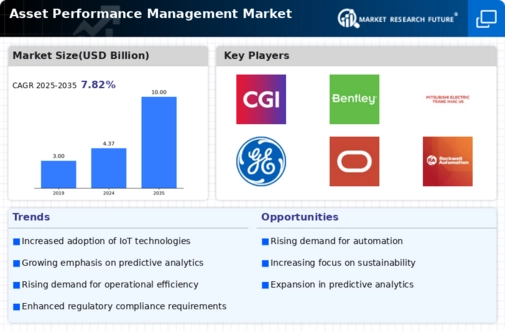Top Industry Leaders in the Asset Performance Management Market

Competitive Landscape of Asset Performance Management Market:
The Asset Performance Management (APM) market is witnessing intense competition as companies strive to enhance operational efficiency and optimize asset performance. Various strategies have been adopted by key players to gain a competitive edge in this dynamic landscape.
Key Players:
- Aspen Technology (US)
- AVEVA Group PLC (UK)
- Detechtion Technologies (Canada)
- IBM Corporation (US)
- Operational Sustainability LLC (US)
- Rockwell Automation (US)
- SAP SE (Germany)
- Bentley Systems Incorporated (US)
- Schneider Electric (France)
Strategies Adopted:
-
Integration of Advanced Technologies: Market leaders are leveraging advanced technologies such as artificial intelligence, machine learning, and Internet of Things (IoT) to develop robust APM solutions. Integration with predictive analytics enhances the ability to anticipate and prevent asset failures, reducing downtime and maintenance costs.
-
Focus on Cloud-Based Solutions: Many companies are shifting towards cloud-based APM solutions to provide scalability, accessibility, and real-time data analysis. Cloud-based platforms enable remote monitoring and management of assets, facilitating quick decision-making processes.
-
Collaborations and Partnerships: Strategic collaborations and partnerships with technology providers and industry stakeholders are common strategies. These alliances allow companies to broaden their product portfolios, access new markets, and strengthen their overall market position.
-
Customization and Tailored Solutions: Offering customizable APM solutions to meet specific industry requirements has become a key strategy. Tailored solutions enhance customer satisfaction and address the unique challenges faced by different sectors, from manufacturing to energy.
Factors for Market Share Analysis:
-
Product Portfolio: The breadth and depth of the product portfolio play a crucial role in determining market share. Companies offering a comprehensive suite of APM solutions covering various industries and asset types are better positioned to capture a larger market share.
-
Geographical Presence: Global reach is a significant factor. Companies with a widespread geographical presence and strong regional partnerships have a competitive advantage. Localization and understanding of regional regulations and specific industry demands contribute to market dominance.
-
Customer Base and Retention: The ability to attract and retain a diverse customer base is critical. Companies with a high customer retention rate and a track record of successful implementations gain a competitive edge, demonstrating the effectiveness of their APM solutions.
-
Innovation and R&D Investment: Continuous innovation and substantial investment in research and development signify a commitment to staying ahead in the market. Companies that consistently introduce new features and functionalities are more likely to gain market share.
New and Emerging Companies:
-
Start-ups with Niche Solutions: Several start-ups are entering the APM market with specialized solutions targeting specific industries or unique asset management challenges. These niche players aim to carve out a space for themselves by addressing specific pain points.
-
Entrance of Technology Giants: Major technology companies are entering the APM space, leveraging their expertise in AI, data analytics, and cloud computing. Their strong financial backing and technological prowess pose a challenge to traditional APM vendors.
-
Focus on Sustainability: Emerging companies are capitalizing on the growing emphasis on sustainability by integrating eco-friendly features into their APM solutions. This includes energy optimization, waste reduction, and overall environmental impact monitoring.
Current Company Investment Trends:
-
AI and Predictive Analytics: Companies are heavily investing in AI and predictive analytics to enhance the predictive maintenance capabilities of their APM solutions. This enables organizations to move from reactive to proactive asset management, minimizing unplanned downtime.
-
Cybersecurity Measures: With the increasing connectivity of assets through IoT, companies are prioritizing cybersecurity investments to protect sensitive data and ensure the integrity of APM systems. Robust cybersecurity measures are critical to maintaining trust among users.
-
User Interface and Experience: Investments are being directed towards improving the user interface and overall user experience of APM solutions. Intuitive dashboards, easy navigation, and user-friendly features contribute to higher adoption rates and customer satisfaction.
-
Expansion of Cloud Infrastructure: Companies are allocating significant resources to expand and enhance their cloud infrastructure. This includes ensuring scalability, security, and seamless integration with other enterprise systems to support the growing demand for cloud-based APM solutions.
Latest Company Updates:
Come 2023, Leading provider of industrial software worldwide Aspen Technologies, Inc., today unveiled new performance and sustainability features for aspenONE®, the company's suite of asset optimisation products that covers design, operations, and maintenance. The new capabilities enhance net zero initiatives, empower engineers with enhanced AI, improve asset health and performance, enable customers to achieve an integrated enterprise data management system, and more. They are designed to accelerate customer digitalization strategies and help customers achieve advanced levels of operational excellence.
Hitachi Energy, a world leader in technology dedicated to promoting a sustainable energy future for everybody, unveiled Lumada APM, the next iteration of its asset performance management (APM) software, in 2023. The release adds two more APMs and strengthens its established asset health prediction product.









